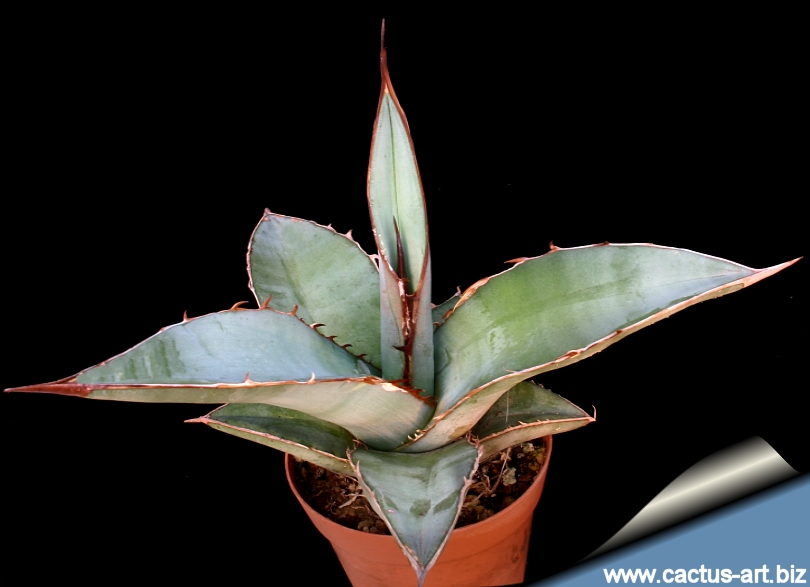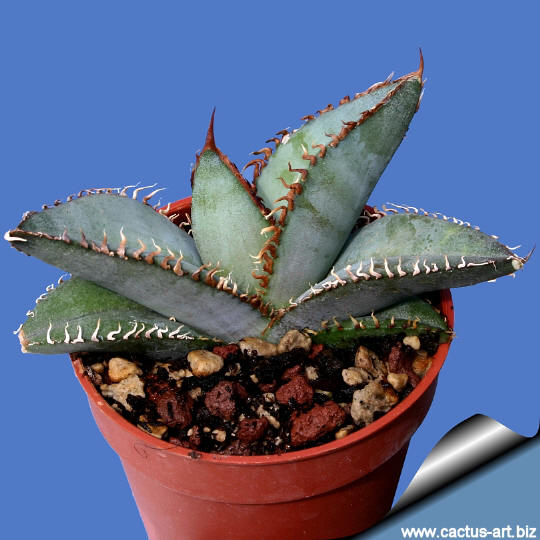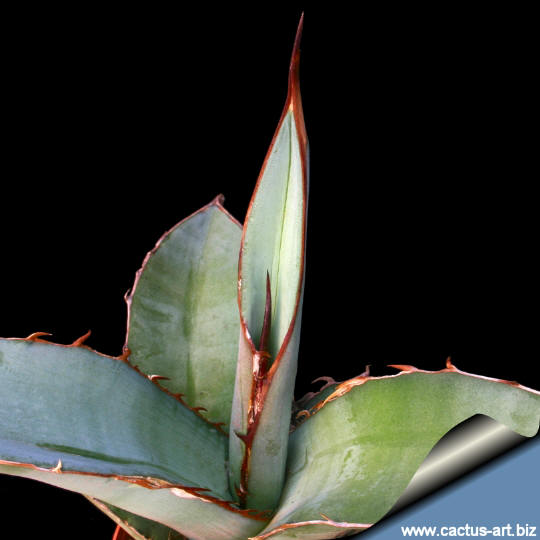|
|
|

Agave titanota (Rancho Tambor )
This is a very odd plant
with ghostly white colored leaves arranged in a typically solitary
rosette. It is an open plant with few leaves, which are 30 to 60cm long
by 12 cm wide and narrow near the base and widest towards their tips
with prominent teats and teeth. Very handsome when big.
|
|
Description: Agave titanota is
a medium sized agave that is extremely robust looking and form a mostly
solitary rosette with wide, open crown of few leaves, up to 75 cm in
diameter.
There are two different looking forms of this plant, the typical
A. titanota defined by Gentry with ghostly white colored leaves
gradually blend in habitat into the squatter round, greener form
described by Felipe Otero (frequently sold as
Agave sp. Sierra Mixteca FO-076), But some blue plants are
found isolated at the edge of. the range of the green populations, with
no green plants around.
Leaves: Wide alabaster-white (in the gentry form), deep
grey-green or pale blue (in the Felipe Otero form) up to 60cm long, 12cm
wide and are broader near the tip and narrower at the base. The margins
of the leaves are lined with varying degrees of teeth from nearly
toothless to broad papery wicked-looking, parchment colored
saw-tooth-like projections.
|
|
Cultivation: It tend to be
slowing than the standard white-grey species plant, hence the
price. They do well in full sun or a lightly shaded area.
In winter watering this plant can be done once every 1-2 months, there
is no need to mist the leaves. Agave titanota is theoretically
hardy to -3° C, particularly when dry
but it is best to avoid severe
freezing temperatures. Heat Tolerance: Excellent
Propagation: Relatively
easy to propagate by seeds or by
suckers (if available) Remove the basal suckers in spring or
summer and let the cuttings dry for a few days before inserting in
compost.
Use: These striking plants
are wonderful when used for accent or simply to provide some all year
round foliage colour and often used in a pot as a patio plant, they make
an eye-catching statement and along with other evergreen plants in pots,
can be moved around to change the scenery or position to give more
shelter.
Photo of conspecific taxa, varieties, forms and
cultivars of Agave titanota.

 |
|
Advertising
|
|
|
|
|
Family: Agavaceae
Scientific Name: Agave titanota Gentry This plant is as Howard Scott Gentry described Agave
titanota in "Agaves of North America" and comes seed collected at or
near the type locality at Rancho Tambor in Oaxaca, Mexico where it grows
on limestone cliffs and ledges.
|
|
Origin: Mexico (Oaxaca)
Habitat: Endemic to limestone hills.
Ecology: Like most Agave species, this plant is monocarpic,
meaning that it will only bloom and bear fruit once during its life
before dying. As Agaves approach maturity at 10 to 30 years of age, they
accumulate a large amount of carbohydrates in their tissues that provide
the energy that fuels the rapid development of the large flower spike.
In nature, pollination by migratory nectar-feeding bats initiates the
production of seeds that will be dispersed by the wind and produce the
next generation of plants.
|
|
|
|

Agave titanota (Rancho Tambor ) A juvenile
specime
 |
|